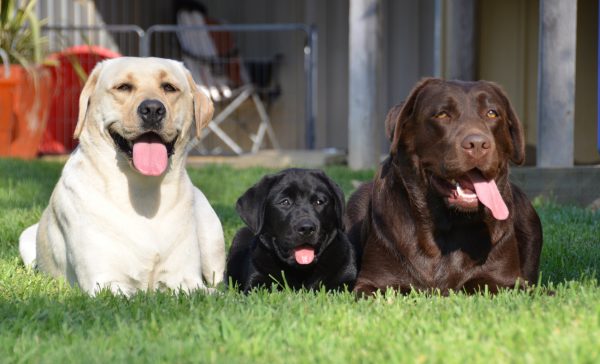Labradors are very friendly, loving, loyal, affectionate and smart. They are amazing family dogs which is why they are so popular and loveable. They are named the most popular dog breed in Australia, the UK, and the USA. When you learn the history of the labrador breed you will understand why this is so. So, where did they originate from?
The labrador was carefully bred up over time by the British sporting gentry from dogs brought back to England in the nineteenth century by early cod fisherman of Newfoundland (Canada). These dogs were found to have unique characteristics which made them exceptional retrievers on both land and water. They were strongly built, short coupled, very active dogs, a hardy breed with exceptionally strong retrieving instincts and a will to please. Added to this they had certain distinct features which enabled them to work under all types of conditions, including their strong head, their weatherproof double coat, their otter-like tail.
These attributes made the dog a very attractive retriever to the nineteenth century sporting shooter. The dog acquired enthusiastic wealthy patrons, among whom was the second Earl of Malmesbury and his friend the Duke of Beccleuch. In 1822, the Earl purchased a ‘black water dog’ from Newfoundland, while the Duke is recorded as having purchased several of these dogs between 1825 and 1835. About this time the third Earl of Malmesbury began to seriously breed these imported dogs and finding the name Lesser Newfoundland far too long decided to call the breed Labrador.
By the end of the nineteenth century the Labrador was well established but only known to a handful of people. In 1903 the Labrador was recognised by the Kennel Council as a separate breed and showing was offered. From this time on, the labrador increased in popularity as he was recognised for his excellent retrieving skills, wonderful temperament, and remarkable adaptability.
The Labrador Breed Standard was drawn up in 1916 after the first Labrador Club was formed. A full Breed Standard (description of the labrador breed) is available on the Australian National Kennel Council site.
The full name of the breed tells you what they are like: Labrador Retriever. Their instinct is to retrieve (bring things back to you). This natural willingness to ‘please’ you is what they are most known for and why they are so kindly natured.

Some of the Characteristics of Labradors (adapted from the Labrador Breed Standard)
- General appearance: There are three recognised labrador colors only – black, chocolate (liver), and yellow. Labs are strongly built, short coupled, very active, broad in the skull and deep chested.
- Characteristics: Good tempered, very agile, excellent nose, keen love of water, adaptable, devoted companion.
- Temperament: Intelligent, keen and biddable, with a strong will to please, kindly nature, no trace of aggression or undue shyness, loving, affectionate.
- Eyes: Medium size brown or hazel, expressing intelligence and good temper.
- Ears: Hanging closely to head and set rather far back.
- Body: Show-line labradors are well-chested, shorter and stockier than the working-line labradors which are a little taller and thinner set. Labradors can get overweight easily which is bad for their joints and their health, so careful diet management is important (don’t let their begging eyes fool you into giving them more food – they would eat everything until they died if given the chance as they are naturally quite food-driven and greedy).
- Tail: Distinctive feature, very thick towards base, short dense coat, otter-like tail.
- Coat: Short and dense, weather resistant undercoat.
- Height: 55-57cms at withers (top of shoulders) when adult.
- Age: Labradors generally live 10-14 years old.
- Activities they love: Anything involving human interaction and companionship, swimming or any water activities, walking, retrieving toys, playing with children, playing with other animals and dogs, obedience training, hide-and-seek games, and pats cuddles and affection.
Probably what they love most is inclusion and to feel like part of the family!
